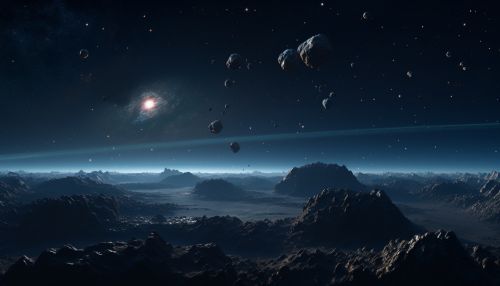Asteroid Belt
Overview
The Asteroid Belt, also known as the main asteroid belt, is a region of space located between the orbits of the planets Mars and Jupiter. It is populated by numerous irregularly shaped bodies called asteroids or minor planets. The asteroid belt is also termed the main belt to distinguish it from other asteroid populations in the Solar System such as near-Earth asteroids and trojan asteroids.


Formation and Evolution
The asteroid belt is thought to be a remnant from the early Solar System, containing raw materials that never coalesced into large planets. The formation of the asteroid belt is a subject of much research and is intimately tied to theories of Solar System formation. It is believed that the material in the belt has been significantly perturbed by the gravitational influences of the giant planets, particularly Jupiter, preventing the formation of a full-fledged planet.
Composition and Structure
The asteroid belt is composed primarily of rock and metal. The asteroids can be categorized into three classes based on their spectral type: C-type, S-type, and M-type. C-type asteroids are carbonaceous and make up the majority of the asteroid belt. S-type asteroids are made up of silicate materials and nickel-iron, while M-type asteroids are metallic nickel-iron.
Exploration
The asteroid belt has been the target of several unmanned space probe missions. The first spacecraft to traverse the asteroid belt was Pioneer 10, which successfully passed through the belt on its way to Jupiter. Subsequent missions, such as the Galileo and Voyager missions, have further explored the asteroid belt, providing valuable data about its composition, structure, and the asteroids that inhabit it.
Significance
The asteroid belt holds significant scientific and economic interest. Scientifically, the asteroids provide a window into the early Solar System, allowing researchers to investigate the processes that led to the formation of planets. Economically, the asteroid belt is of interest due to the potential for asteroid mining, with asteroids potentially serving as sources of precious metals and other resources.
